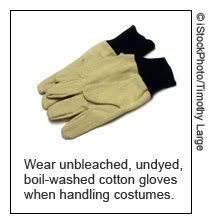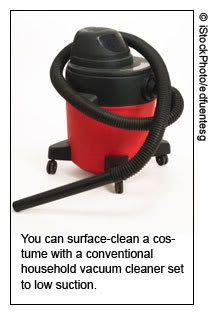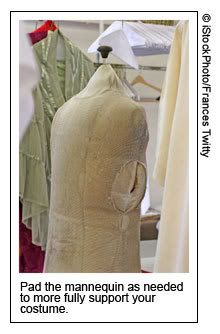by Jane Robinson and Tuule Pardoe, (c) 2000, Museum & Galleries Commision, London.
This blog entry is by Ray Cole, of the Star Trek Prop, Costume & Auction Forum
 I recently purchased my first screen-used costume from It's a Wrap—a wonderful two-piece "command-red" Star Trek: The Next Generation Starfleet uniform. I was thrilled to get it, but as I took it out of the box for the first time, the awesome responsibility I'd accepted hit me: the proper care and preservation of this historic Star Trek item is now up to me!
I recently purchased my first screen-used costume from It's a Wrap—a wonderful two-piece "command-red" Star Trek: The Next Generation Starfleet uniform. I was thrilled to get it, but as I took it out of the box for the first time, the awesome responsibility I'd accepted hit me: the proper care and preservation of this historic Star Trek item is now up to me! My background is in computer science and instructional design, not museum studies or textile conservation. Costume care seems to be one of the more complex art conservation tasks, too. Prior to this purchase, my collection consisted entirely of "wall art"—pre-production sketches and paintings, and production signage. It's relatively clear how to take care of such items: take them to a reputable frame shop and have them framed in archival, unbuffered acid-free mats, unbuffered acid-free backing board, and ultra-violet (UV) filtering plexiglass. The UV-filtering protects the art against fading, and the plexiglass protects the art against damage from shattering (an issue for those of us living in California earthquake territory). Unfortunately, there are no comparable shops where you can take a Hollywood costume to have it prepared for safe, archival display.
This is the age of the Internet, though, so no one is without resources. After a bit of searching, I found a useful document aimed at professional museum curators: An Illustrated Guide to the Care of Costume and Textile Collections ("MGC Guide"), published by the Museums & Galleries Commission (MGC), a national advisory board for museums in the United Kingdom.
The MGC Guide is divided into five chapters: Basics, Collection Maintenance, Storage, Display, and Specialist Help.
Basics
The Basics chapter introduces many of the terms used throughout the rest of the document, and lays out some basic rules. Key recommendations from this chapter include:
 Avoid unnecessary touching, handling, and moving. "Physical forces such as twisting, shaking, pulling, snagging and rubbing...cause materials, already weakened by age and wear, to suffer catastrophic damage." [p. 7]
Avoid unnecessary touching, handling, and moving. "Physical forces such as twisting, shaking, pulling, snagging and rubbing...cause materials, already weakened by age and wear, to suffer catastrophic damage." [p. 7]
Collectors buy costumes for all kinds of reasons, including the desire to try them on or wear them to conventions. However, the MGC Guide warns that skin oils and salts can transfer to the surfaces of your costume. Over time, such areas will "become visible as yellowish, greasy discoloration[s]." [p. 7] The MGC Guide therefore explicitly states that "costumes in museum collections should never be tried on." [p. 7].
It additionally recommends that you should move the costume as seldom as possible. When you must move a costume, you should provide as much support as you can. Two simple support methods suggested by the guide are to either lay the costume horizontally on acid-free boards, or to support the top with a padded hanger held in one hand with the bottom draped over your other forearm. You should wear unbleached, undyed, boil-washed cotton gloves whenever handling costumes or textiles.- Use barriers where necessary. There are many possible approaches to displaying costumes. Some collectors like to put the focus on the costume itself as an independent artifact; others like to put the costume on a life-like mannequin as one element in a larger, life-sized diorama, with starship wall panels, turbolift doors, or other scenery (whether original screen used or replica) in the background. This latter approach presents problems because materials commonly used to build such scenery (e.g., wood or medium density fiberboard (MDF)) can give off fumes and gasses which can damage textiles. When such materials are placed inside an enclosed space with a costume (as in a glass booth or showcase, for example), the negative affects of outgassing are accelerated. Furthermore, paints and varnishes do not provide sufficient protection. So the MGC Guide recommends coating the surfaces of such materials with "a metalised plastic film" [p. 8].
Specific brands mentioned include Marvelseal, Moistop, and Seet. I couldn't find any online information about Seet. The other two products don't seem to be transparent, so I'm a bit confused about how to use them to seal up vapors from wood or MDF scenery. It appears that you can paint over the Moistop sealant, but then wouldn't the paint vapors be an issue? Alas, the MGC Guide is unclear on this point.
Collections Maintenance
This chapter covers basic tools and equipment, workspace design, staff training, housekeeping, storage, labeling, and cleaning procedures. Key recommendations from this section include:
- Incoming textiles and costumes should be quarantined before being displayed or stored with the rest of the collection. This is to allow for monitoring for pest infestation. If the incoming item is infested, it should be sealed in a clear polythene bag. The MGC Guide is, unfortunately, not specific about how long the item must remain sealed. It refers readers instead to a different document, Integrated Pest Management by Pinniger and Winsor, published by the MGC in 1998, but I haven't read it.
However, while searching for information about Marvelseal (see above), I found a web page about anoxics on the Sorbent Stystems site. It says "Anoxic storage is a method of storing artifacts in a low-oxygen environment. It slows deterioration...and is now the favored means of non-toxic insect eradication (research indicates that most insect infestations will be eliminated in an anoxic environment in from 5 days to 2 weeks at less than 0.5% oxygen)." It goes on to say: "Create an airtight microenvironment with a flexible oxygen barrier film and remove the oxygen using an oxygen absorber." Sorbent Systems claims to sell everything you need, including the bags and oxygen absorbers, but I have not personally tried them yet. - Only surface cleaning is part of regular collection care activities.
 Dry or wet cleaning is best left to conservators. To surface-clean garments, you can use a household vacuum cleaner. Set the machine to low suction, and cover the nozzle with netting—this is to prevent any small items (like buttons or beads) that might come loose from being lost in the vacuum cleaner bag. If necessary, you can use a soft brush with natural bristles to help break particles free from the garment and into the stream of suction.
Dry or wet cleaning is best left to conservators. To surface-clean garments, you can use a household vacuum cleaner. Set the machine to low suction, and cover the nozzle with netting—this is to prevent any small items (like buttons or beads) that might come loose from being lost in the vacuum cleaner bag. If necessary, you can use a soft brush with natural bristles to help break particles free from the garment and into the stream of suction.
Storage
 For costumes, there are two common storage methods: storage on hangars, or storage in boxes. The MGC Guide points out that "for small collections and those that are not cared for by a costume specialist, boxing and racking is a better option than hanging." [p. 28] It presents four reasons, the most compelling of which is that with boxing "there is less risk of serious permanent damage than from hanging." [p. 28]
For costumes, there are two common storage methods: storage on hangars, or storage in boxes. The MGC Guide points out that "for small collections and those that are not cared for by a costume specialist, boxing and racking is a better option than hanging." [p. 28] It presents four reasons, the most compelling of which is that with boxing "there is less risk of serious permanent damage than from hanging." [p. 28] Key recommendations with respect to storing costumes in boxes include:
- The boxes should have length and width that match that of the unfolded garment (best practice) or have width of the unfolded garment and length that requires only one or two folds across the garment (basic practice).
- The boxes should be constructed of buffered acid-free box board lined with unbuffered tissue (best practice) or if you use regular cardboard boxes instead, they should be lined with buffered acid-free tissue (basic practice); the tissue must be checked annually, and a regular program of replacement for the boxes must be implemented.
- Lids should be sufficient to keep dust out but not so tight as to create suction when lifted or to require shaking the box to loosen.
- Place garments in boxes so that the most identifiable features of the garment end up visible on top.
- Cushion the folds in the garment with crumpled tissues to prevent creasing.
 Before storing costumes on hangers, the MGC Guide recommends assessing their suitability for hanging by answering the following questions:
Before storing costumes on hangers, the MGC Guide recommends assessing their suitability for hanging by answering the following questions: - Can the shoulder area support its own weight? If the costume has only narrow shoulder straps, or flimsy material at the shoulders, it should be stored in a box, not hung.
- Is the fabric susceptible to distortion? Costumes made of knitted or bias-cut fabrics should be stored in a box, not hung.
- Is the weight of the costume evenly distributed? Costumes that are bottom heavy should be stored in a box, not hung.
- Does the costume have tears or other damage in the fabric? If the garment has many areas of weakness or widespread damage, store it in a box, not on a hanger.
- Does the costume have loose trimmings? Costumes with loosely attached parts, such as loose lace, beads or fringe should be boxed, not hung.
If, after going through the checklist above, you decide that your costume is suitable for hanging, the MGC Guide recommends the following tips to improved the safety of your hung garments:
- Don't overcrowd the rack. A common myth is that hanging costumes takes less space than boxing them. This is not true unless you overcrowd the hanging costumes, which causes more damage than overcrowding in boxes. The guide suggests allowing a maximum of 10-12 items per meter of rail "for pre-20th century garments or any tailored garments," or "up to 20 items of children's wear [or small aliens like Ferengi?] or ladies 20th-century dresses." The guide is silent about rail ratios for 22nd-, 23rd, 24th-century and later garments, so Star Trek collectors will have to extrapolate.
- Store costumes in furniture made of metal, not wood, with rails at least 1.8 meters above the floor.
- Prior to hanging, place costumes in loose, side-opening garment bags made of boil-washed cotton that is unbleached and undyed.
- Cover wooden hangers in aluminum foil, then wrap them in boil-washed undyed and unbleached cotton stuffed with polyester wadding to provide cushioned support to your costume and protect it from acid and other pollutants in the wood.
Display
 One important goal to keep in mind when selecting a display method is to ensure that the costume is as fully supported as possible. You want a display that spreads the weight of the costume around evenly. This means, in particular, never using pins to hang or display a costume, since they concentrate stresses locally and result in an uneven distribution of weight. Other key recommendations in this section include:
One important goal to keep in mind when selecting a display method is to ensure that the costume is as fully supported as possible. You want a display that spreads the weight of the costume around evenly. This means, in particular, never using pins to hang or display a costume, since they concentrate stresses locally and result in an uneven distribution of weight. Other key recommendations in this section include:- Exclude ultra-violet (UV) light from all light sources. Keep visible light levels and duration of exposure to a minimum.
- Display costumes in sealed, metal framed showcases that have been specially designed for museum use (best practice) or build your own from conservation-quality materials and include controlled ventilation.
- Mannequins play an important role in supporting a costume on display, but often do not provide enough support by themselves. In such cases, padding should be used to fill out the form and properly support the costume. Although padding can help provide needed support to the costume, it "never achieves complete support, since appearance dictates that some semblence of draping is desirable to make garments look natural, rather than stuffed."[p. 39]
Specialist Help
The final chapter covers Specialist Help. It gives a brief overview of some services that textile and art conservators can offer, and provides some contact information for a limited number of United Kingdom-based conservation resources.
Overall, the MGC Guide is worth reading. It's not very long, though it can be a bit dense. It won't answer every question, but it does provide a good starting point.
I'd like to end with some pointers to other resources and a plea that we continue the discussion about how to conserve and care for the items in our collections over on the discussion forum.
Resources
- If you're going to be attending the Comic-Con International in San Diego this year and can stay in San Diego an additional week, the Balboa Art Conservation Center is putting on a three-day Focus on Collections Care workshop in San Diego's Balboa Park from July 30 through August 1. I'm signed up for "Preserving Museum Collections 101", "Care of Collections: Books", and "Care of Collections: Textiles". Maybe you'd like to join me?
- One source of conservation-quality mannequins I've been able to find is Dorfman Museum Figures. Their Conservation Forms are made from conservation-safe materials, and they also sell padding shirts for bulking out mannequin forms, and padded, conservation-quality hangers, should you choose to store your costumes by hanging instead of in boxes.
No comments:
Post a Comment